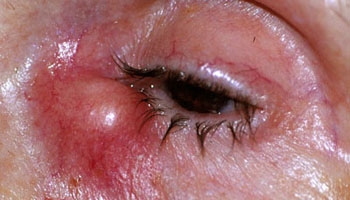Tears are secreted naturally in our eyes in order to maintain the natural moisture for pain-free vision. Most tears are drained from the eyes but some excess tears are collected and transmitted via lacrimal sac into the nasal cavity. The lacrimal sac is anatomically located at the inner corner of your eye and leads into the nasal passageways via lacrimal duct, a narrow tube that transfers the excess tears into the nasal cavity. Dacryocystitis takes place when you feel irritation and swelling in this sac, which will lead to dryness of eye with other disturbing symptoms. Dacryocystitis can also be a result of an infection.

Types of Dacryocystitis
Acute Dacryocystitis
When the tear duct gets blocked or if there is a stone present at the opening of the duct, the condition is referred to as acute Dacryocystitis. The blockage of the opening of tear duct can result in the retention or accumulation of tears and mucous inside the sac, which may increase the propensity to develop infections. This can be due to several causes including chronic inflammation, sinus problem, acute physical trauma and tumour in extremely rare case. Some other causes include systematic conditions like sarcoidosis, tuberculosis or Wegener’s disease.
Some signs and symptoms of acute dacryocystitis include:
Appearance of a painful lump in between your eyes and the nose, which is red in color.
You may not be able to open your eyes due to the swelling, but it happens only in extreme cases.
You may have acute dacryocystitis with non-specific symptoms and localized raised temperature.
An abscess that is acute and tender.
Chronic Dacryocystitis
Chronic dacryocystitis is a condition that usually follows an untreated or poorly managed acute dacryocystitis. It is imperative to mention that in most cases, this is a result of ongoing discharge from the eye, which results in the formation of an abnormal fistula formation over the sac. The most common symptom of chronic dacryocystitis is tearing or excessive watering of eyes, but it may also obstruct the tears' outflow, debris and epithelial cells from the eye surface.
Conditions That Are Commonly Associated with Dacryocystitis
Conjunctivitis
This is the characteristic disease that shows how harmful debris can be to our eyes. It can be also caused by the exotoxins produced by staphylococcal organisms, which is present as a normal commensal outside the eye and does not get cleared by usual tearing process.
Cellulitis
It is a serious condition that is marked by excessive colonization of bacteria as a result of the rupture or significant damage to the lacrimal sac walls that surrounds the soft tissue inside. It is mostly associated with acute dacryocystitis.
Orbital Cellulitis
It is a uncommon yet very serious condition that is also associated with dacryocystitis. It is mostly linked to acute dacryocystitis and congenital acute dacryocystitis. In most cases, it presents with an extremely inflamed eye, unbearable pain on pupillary examination and irregular motility. It also decreases the sharpness of vision.
Decreased Visual Acuity
It is one of the most common complaints reported by dacrocystitis patients. It is defined as a substantial decrease in the sharpness of eye's vision and is mostly a result of an overgrowth of the tear film which diverts the light on eye surface. This condition is marked by abnormal composition and proportion of the three layers of tear films which are mucus, oil and aqueous.
Periorbital Edema
This is due to the presence of dangerous debris on the eye’s surface. In addition, the accumulated debris aggravates the risk of infection and secretion of exotoxins that further destroys visual functioning.
Treatments of Dacryocystitis
The dacryocystitis treatment should be started as soon as you notice the symptoms. In case there are no symptoms of infection but your tear duct is blocked, your eye specialists may suggest these solutions:
Compress the surface with warm material
Massage the duct gently to drain in order to minimize the risk of infection
The most common and standard treatment for dacryocystitis is medicines, such as antibiotics. These pharmacological agents can help in reducing the symptoms and clearing up the infection. Most cases of acute dacryocystitis are easily treatable with the eye drops and antibiotic ointments, but you should be very careful when applying the ointments and must check whether they can be applied on eyes or not, otherwise you may develop other serious eye infections.
Minor surgical intervention may be required if antibiotics don’t work. Surgical intervention is a highly successful treatment for dacryocystitis. And actually, the results are 95% successful. Below are two kinds of surgeries that are commonly applied.
Balloon dacryoplasty. In this surgery, balloons are used to open the thin tear ducts. It is not successful as an endonasal approach and the success rate for complete obstructions is only 40.8% according to a recent clinical study. This approach is contraindicated in acute dacryocystitis, nasolacrimal duct posttraumatic obstruction and dacryocystolithiasis and is more suitable for patients having circumscribed crucial stenosis or nasolacrimal duct occlusions.
Endonasal approach with laser or without laser. It is more suitable for cases of chronic dacryocystitis. It helps in restoring the flow of tears into the nose from the lacrimal sac. During surgery, a hole is made in between the sac and the lacrimal fossa to restore the tear flow. After surgery, the tubes and drains are attached to cover the empty space and fill the gap. Below is video that explains the approach in detail.


View All Comments /Add Comment